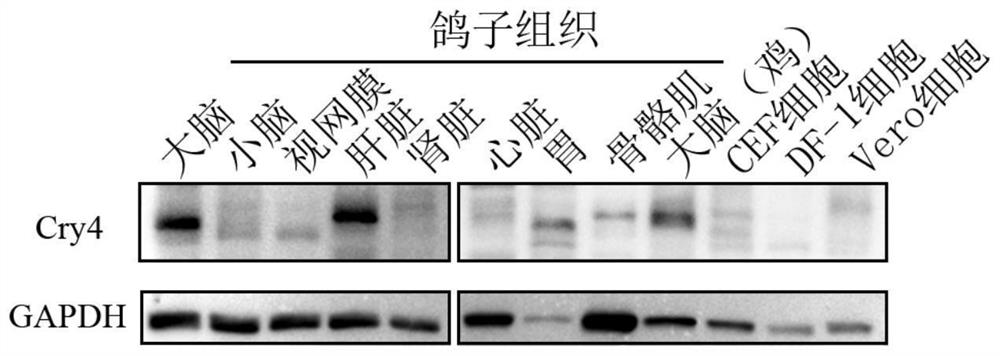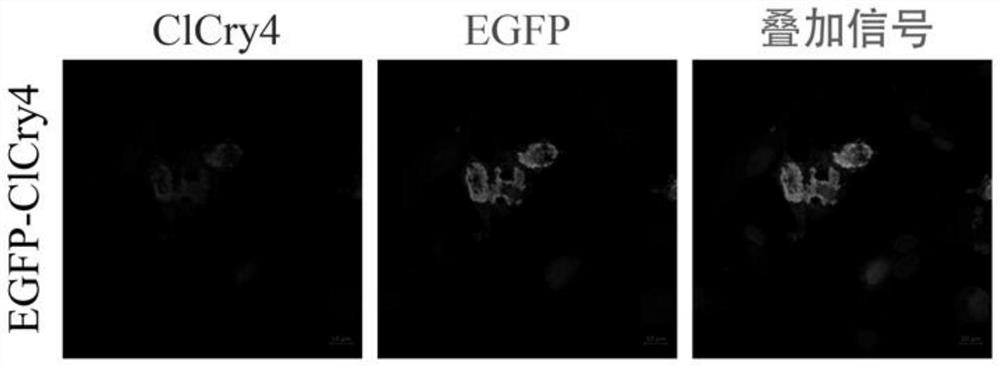Antigen applicable to production of anti-cryptochrome 4 antibody
A cryptochrome and antigen technology, applied in the field of genetic engineering, can solve the problems of insufficient species versatility, difficulty in applying cryptochrome 4 protein detection, insufficient antigen specificity, etc.
- Summary
- Abstract
- Description
- Claims
- Application Information
AI Technical Summary
Problems solved by technology
Method used
Image
Examples
Embodiment 1
[0030] The construction of embodiment 1 antigen expression vector
[0031] After total RNA was extracted from pigeon midbrain tissue using Tiangen’s total RNA extraction kit, the first-strand cDNA was synthesized using Thermo’s Maxima H First Strain cDNA Synthesis Kit. Afterwards, the first-strand cDNA was used as a template, and the KAPA HiFi HotStart ReadyMix PCR Kit from Kapa Company was used to carry out the PCR process (Sense primer: CTTGGATCCAGCGCGTTTCTCCACCACTACACG; Antisense primer: AGCAAGCTTTTCCCTCCCCCCTGGCCACCTTTC), the PCR conditions were: 95°C for 3 min, (98°C for 20 s, 60°C 15s, 1min at 72°C) a total of 25 cycles, 1min at 72°C.
[0032] The PCR product was recovered using the NucleoSpin Gel and PCR Clean-up kit from MACHEREY-NAGEL. The purified DNA and pET21a vector were digested with BamHI and HindIII respectively, and then the two were gel recovered. After the purified product was ligated overnight at 16°C using T4 DNA ligase, the product was transformed into ...
Embodiment 2
[0033] Example 2 Expression and purification of Cry4-Ctem
[0034]Transform the expression vector into the BL21(DE3) strain, and inoculate a single clone into 5 mL of LB liquid medium added with ampicillin after coating, grow overnight at 220 rpm at 37°C, and inoculate them all into 1 L of liquid medium added with ampicillin. LB liquid medium. Keep the shaker at 37°C and 220rpm to make the bacteria grow rapidly. When the OD600 is in the range of 0.8-1.0, add IPTG with a final concentration of 1 mM to the culture medium, lower the temperature of the shaker to 22°C, and continue culturing for 16 hours, then centrifuge at 4000 rpm for 30 minutes to collect the bacteria. Add 30mL lysis buffer (50mM NaH2PO4, 200mM NaCl, 10mM imidazole, pH 8.0) to the cells, then add lysozyme at a final concentration of 0.2mg / mL and 0.1mM protease inhibitor AEBSF, and incubate on ice for 30min The bacteria were initially lysed. After that, ultrasonic crushing was carried out, and the ultrasonic w...
Embodiment 3
[0035] Example 3 Preparation of Anti-Cryptochrome4 polyclonal antibody
[0036] The purified antigen was dialyzed at 4°C to 0.01M, pH = 7.2 phosphate buffer, and the protein was used as the final antigen to subcutaneously immunize New Zealand big-eared white rabbits for a total of 5 times, with an interval of 2 weeks between each immunization . The first immunization was emulsified with complete Freund's adjuvant, the second to fifth immunization was boosted with incomplete Freund's adjuvant, and each immunization used 0.5 mg of antigen. One week after the fourth immunization, blood was collected for Elisa detection.
[0037] In Elisa detection, first use NaHCO 3 Dilute the antigen in the buffer solution to a concentration of 2 μg / ml, add 100 μl of the diluted antigen to each well of a 96-well plate, and coat at 4°C overnight; use 5% skimmed milk powder to block for 2 hours; press 1:2000, 1: 4000, 1:8000, 1:16000, 1:32000, 1:64000, 1:128000, 1:256000 for doubling dilution o...
PUM
 Login to View More
Login to View More Abstract
Description
Claims
Application Information
 Login to View More
Login to View More - R&D
- Intellectual Property
- Life Sciences
- Materials
- Tech Scout
- Unparalleled Data Quality
- Higher Quality Content
- 60% Fewer Hallucinations
Browse by: Latest US Patents, China's latest patents, Technical Efficacy Thesaurus, Application Domain, Technology Topic, Popular Technical Reports.
© 2025 PatSnap. All rights reserved.Legal|Privacy policy|Modern Slavery Act Transparency Statement|Sitemap|About US| Contact US: help@patsnap.com



